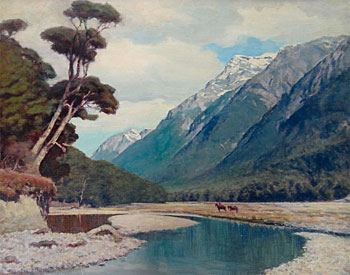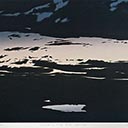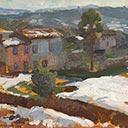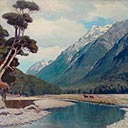Eglinton Valley
39 x 50 cm
est. $1,000 - 1,500
Marcus King was born in 1891. In 1905, as a teen, he won a junior cadetship in the architectural division of the Public Works Department in Wellington. Two years latter he attended evening classes with Edward Fristrom at the Elam School of Art. He and Fristrom painted together around the Auckland area and developed a freindship. King returned to Wellington in 1915, Friström stayed with him and the two of them continued working together and exhibiting at the New Zealand Academy of Fine Arts. Later that year King later enlisted in the army. After returning from the War, King left the civil service and became a commercial artist. During this time he also taught art at the Wellington Technical Institute. It was King's practice as a well-established commercial artist that led him to join the Quoin Club. The club, which borrowed its name from the printing process, promoted the fostering of Arts & Crafts in Auckland. Together, the club and King promoted the idea of utilizing traditional commercial printing processes in order to create works of fine art. This experience is evident in King's commercial advertising posters.
During his commercial career, King served on the arts council from 1929 until the early 1940s with artists Nugent Welch, Mary Elizabeth Tripe and Dorothy Kate Richmond. He continued to exhibit at the Academy until 1964. After ten years of working in various agencies, King returned to the civil service in 1935. Marcus King is perhaps best known for the significant body of commercial and fine art work that he created for the New Zealand Tourism Department. King's paintings and posters were of such quality that they were sent all over the world, marketing the pristine beauty of Aotearoa, New Zealand.
Having established himself as a painter of considerable ability, King received numerous commissions. The Wellington City Council commissioned an oil painting of the city and harbour, which was given by the city to Lord Freyberg when he finished his term as Governor General. Another commission saw two of his paintings destined for the South Pole. One of his favourite projects during this time was a series of paintings depicting Maori life prior to the arrival of the Europeans. A large scale oil titled 'The Arrival' was sold at International Art Centre in 2011 for a record $15,250.
Marcus King was described by those that knew him as 'small and sprightly' with a 'huge personality', a religious man who was widely admired for his creative talents.





